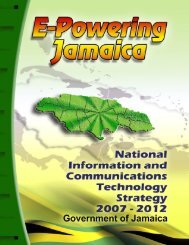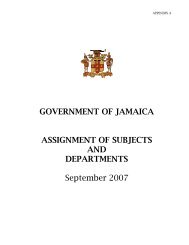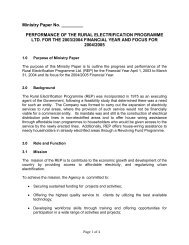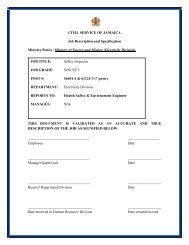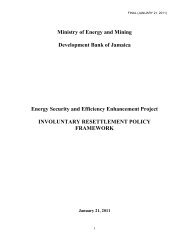Jamaica Biofuels Report - Ministry of Energy
Jamaica Biofuels Report - Ministry of Energy
Jamaica Biofuels Report - Ministry of Energy
Create successful ePaper yourself
Turn your PDF publications into a flip-book with our unique Google optimized e-Paper software.
welfare, but sustainable production will need modern production technology and higherinvestments.Coconut Palm• CharacteristicsCoconut palm is a perennial plant that produces a fruit with the highest oil content <strong>of</strong> anyterrestrial plant. The oil content in coconuts can easily reach 80%. Generally, the coconut fruitand its oil have too high value to be used as a bi<strong>of</strong>uel, but coconut shells can also be used toproduce energy,• Experience in similar conditions to <strong>Jamaica</strong> as a feedstock for biodieselThe oil and other products <strong>of</strong> this crop have high market prices in Brazil for humanconsumption, so except for residues, which are burned as fuel in boilers, they are never used asa bioenergy source there. On the other hand, coconut palm has been used as the feedstock forbiodiesel in the Philippines where it is the basis for that country’s mandated B2 blendedbiodiesel for vehicle use.• Use <strong>of</strong> Coconut as a source <strong>of</strong> Bi<strong>of</strong>uel in <strong>Jamaica</strong>For <strong>Jamaica</strong>, the primary use should be for human consumption, and as tourism is a majorindustry in <strong>Jamaica</strong>, it would not be recommended that this product be used for fuel, with sucha high demand by tourists and locals alike. Besides that, coconut trees in <strong>Jamaica</strong> have beeninfected by a disease called “yellowing” that killed coconut plants throughout the island. Thisdisease could be related to poor drainage, as it was diagnosed in Brazil, but there is noconfirmation <strong>of</strong> those conditions causing the problem in <strong>Jamaica</strong>.• Significant <strong>of</strong> the loss <strong>of</strong> <strong>Jamaica</strong>n tall varieties by lethal yellowing and other diseasesIt is quite dangerous to include this crop with that infection potential that may harm otheroptions. It will be needed investments in breeding and cultural practices that only will havereturn in long term.• How it compares to castor as an optionIt loses in any comparison if the goal is to produce biodiesel. On the other hand, it probably willbe more pr<strong>of</strong>itable for the growers because <strong>of</strong> the high values <strong>of</strong> its products for humanconsumption. The costs are higher as the risks compared to castor to produce oil for fuel.Africa Oil Palm• CharacteristicsOil palm is a crop that can be grown in areas with higher slopes than 12%. It is considered semiperennialsince it produces 3 years after planting and continues to 25 years with the peak <strong>of</strong>production happening after 7 to 9 years. It has many advantages in tropical areas, because itcan grow with other crops (vegetables) in inter-row systems during most <strong>of</strong> its cycle. It can bemanually cultivated and can produce yields from 7 tonne/ha <strong>of</strong> fruits in the third year,increasing to 14 tonne/ha in the fourth year, and reaching 25 t/ha at maturity with stable21



